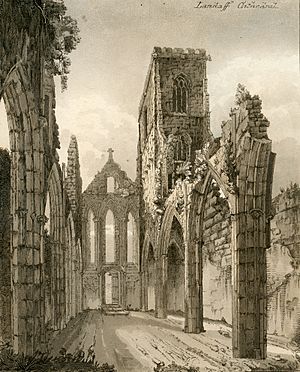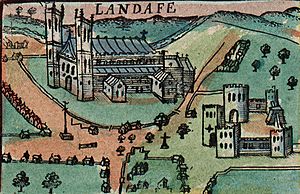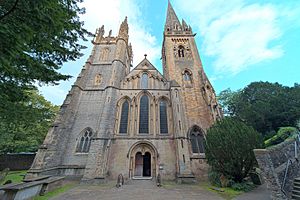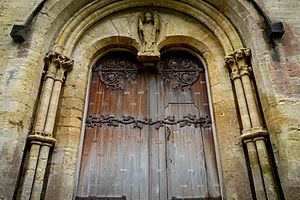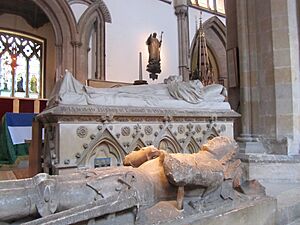Llandaff Cathedral facts for kids
Quick facts for kids Llandaff Cathedral |
|
|---|---|
| The Cathedral Church of Saints Peter and Paul with Saints Dyfrig, Teilo, and Euddogwy | |
|
Eglwys Gadeiriol Llandaf
|
|
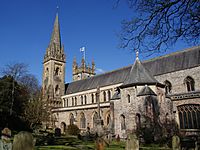 |
|
| 51°29′45″N 3°13′04″W / 51.4957°N 3.2179°W | |
| Location | Cardiff |
| Country | Wales |
| Denomination | Church in Wales |
| Previous denomination | Roman Catholic |
| History | |
| Status | Cathedral |
| Founded | 1120 |
| Architecture | |
| Functional status | Active |
| Style | Medieval, Gothic |
| Administration | |
| Diocese | Llandaff |
Llandaff Cathedral (Welsh: Eglwys Gadeiriol Llandaf) is a beautiful church in Llandaff, Cardiff, Wales. It is part of the Church in Wales and is the main church for the Bishop of Llandaff. The cathedral is dedicated to Saint Peter and Saint Paul, along with three important Welsh saints: Dubricius (Dyfrig), Teilo, and Oudoceus (Euddogwy). It is one of two cathedrals in Cardiff.
The building you see today was started in the 12th century. It stands on the site of an even older church. Over the centuries, the cathedral has faced many challenges. It was badly damaged in 1400 during the rebellion led by Owain Glyndŵr. Later, during the English Civil War, Parliamentarian soldiers caused more damage. A huge storm in 1703 also harmed the building. By 1717, the damage was so bad that people thought about moving the bishop's main church somewhere else.
After more storms in the 1720s, work began in 1734 on a new design by John Wood, the Elder. However, this plan was never fully finished. Instead, a big restoration project was carried out by John Prichard in the 1840s and 1850s. In January 1941, during the Cardiff Blitz in Second World War, a bomb severely damaged the cathedral, blowing off the roof of the main hall (nave).
The older parts of the cathedral are mostly made from stone from Somerset, England. Newer parts, built after the war, use concrete and local Welsh sandstone. The roofs are made of Welsh slate and lead. In 2007, the organ was damaged by lightning. This led to a successful fundraising effort to get a brand new organ.
Llandaff Cathedral has a traditional choir of boys and men, and also a girls' choir. It is home to the Cathedral School, Llandaff, which is the only dedicated choir school in the Church in Wales. The cathedral also holds the tombs of important figures like Dubricius and Teilo, who were early Welsh saints. Many Bishops of Llandaff are also buried here.
Contents
A Look at the Cathedral's Past
Ancient Beginnings
Experts agree that the Norman cathedral was built where a very old Celtic church once stood. However, no one is completely sure how old this first church was or how big it was.
The Legend of Lucius
Welsh stories say that the church was founded by Lucius. He was a legendary king from the 2nd century and is believed to be the first British Christian. The legend says Lucius asked Pope Eleutherius to send Christians to Britain. The Pope then sent a mission to build Britain's first church.
Some old Welsh writings, called the Welsh Triads, connect this story to Llandaff. They say Lucius "made the first Church at Llandaf, which was the first in the Isle of Britain." Even though this Lucius story is now thought to be a legend, it was widely believed in the Middle Ages.
Saint Dyfrig and Saint Teilo
Later stories by writers like Geoffrey of Monmouth and Iolo Morganwg say that the Christian community at Llandaff was restarted by Saint Dyfrig and his follower, Saint Teilo. These two saints are linked to the famous King Arthur in some legends.
The Normans, who built the current cathedral, saw Dyfrig and Teilo as the original founders. Today, they are, along with Oudoceus, the cathedral's patron saints. Many old remains at the site, like an ancient Celtic cross, suggest that a church has been there for a very long time.
The Norman Cathedral
The Normans took control of Glamorgan early in their conquest of Wales. They appointed Urban as the first bishop in 1107. He started building the cathedral in 1120. He also moved the remains of Saint Dyfrig to Llandaff. The building work was likely finished around 1183. The cathedral was dedicated to Saints Peter and Paul, and also to Dyfrig, Teilo, and Oudoceus.
Around 1214, Bishop Henry de Abergavenny organized the Llandaff Cathedral chapter, which is the group of clergy who run the cathedral. He made changes to the bishop's seal, adding more detail to the image of the bishop. By 1266, the cathedral had been changed and was dedicated again.
The Lady Chapel was built by William de Braose, who was bishop from 1266 to 1287. This chapel was added to the back of the church. After the Lady Chapel was finished, other parts of the church were rebuilt slowly over time.
In 1400, Owain Glyndŵr's rebellion caused serious damage to the church. His forces also destroyed the Bishop's Palace. The damage was so bad that in 1575, Bishop William Blethyn thought the cathedral might be beyond repair. Most of the damage was fixed later, especially by Bishop Marshall. The northwest tower, which doesn't have a spire, was added by Jasper Tudor. He became the lord of Cardiff after his nephew, King Henry VII of England, came to power.
From Medieval Times to the Victorian Era
During the English Civil War, Parliamentarian soldiers took over the cathedral. They burned the books from the cathedral library at Cardiff Castle. A man named Milles even used parts of the cathedral for his own purposes. He set up a tavern inside, used part of it as a stable, and turned the choir area into a pen for his calves. He even used the font as a trough for his pigs!
The southwest tower was badly damaged in the Great Storm of 1703. By 1720, it was falling apart. The damage was so severe that in 1717, the church considered moving the bishop's seat to Cardiff. More storms between 1720 and 1723 caused more damage, including parts of the roof falling down. After the roof collapsed in 1723, services had to be held only in the Lady Chapel.
Thirty years later, in 1734, an architect named John Wood, the Elder started work to restore the cathedral. Wood designed a new section in an Italian temple style, but he only worked on the eastern part of the building. The western half remained in ruins.
For almost 300 years, the bishops of Llandaff did not live in Llandaff. In 1836, there was another attempt to move the bishop's seat, this time to Bristol. After this failed, the important role of Dean was brought back to Llandaff. This position had not been filled for 700 years! The new Dean, William Bruce Knight, helped start the much-needed restorations.
Enough restoration was done for the cathedral to reopen for services on April 16, 1857. The cathedral was greatly restored, the tower was rebuilt, and a spire was added. Much of this work was done by local architect John Prichard between 1843 and 1869. Famous artists like Dante Gabriel Rossetti and Edward Burne-Jones created beautiful artworks for the cathedral.
From 1691 until about 1860, there was no choir or organ at the cathedral. In 1860, Bishop Alfred Ollivant wrote a book to raise money to restore the choir and buy a new organ. A cathedral school has existed since the 9th century. It was reorganized in 1888 and started accepting girls in 1978.
The 20th and 21st Centuries

On January 2, 1941, during the Cardiff Blitz in the Second World War, a bomb exploded near the cathedral. It blew the roof off the main hall (nave), the south aisle, and the chapter house. The top of the spire also needed to be rebuilt. Work began quickly to clear and repair the Lady Chapel and Sanctuary, which finished in April 1942. Further repairs had to wait until after the war. Of all British cathedrals, only Coventry Cathedral was damaged more. Because of its importance, the cathedral was given Grade I building status on February 12, 1952.
Major repairs and changes were made by architect George Pace of York. The building was back in use by June 1958. Queen Elizabeth II attended a service celebrating the completion of the restoration on August 6, 1960. The Welch Regiment Memorial Chapel was built. Also, Jacob Epstein created the impressive "Christ in Majesty" sculpture, which stands above the nave on a concrete arch designed by George Pace.
In February 2007, the cathedral was hit by a severe lightning strike. This badly damaged the electrics of the organ, which was already in poor condition. The organ could not be used after this. This led to an appeal to raise £1.5 million for a completely new organ.
Cathedral Design and Structure
The original church, before the Normans, was quite small. It was only about 28 feet long, 15 feet wide, and 20 feet high. The construction of a much grander building began in the 1120s under Bishop Urban. However, this building didn't last long. A large construction project took place between 1193 and 1218. The western parts of the church, including the nave and front, were rebuilt and still stand today. The excellent quality of the work suggests that skilled craftsmen from Somerset were hired.
Even though some changes were made in the 13th and 14th centuries, and Jasper Tudor funded a northwest tower, by the late 1500s the church was in bad shape. In 1594, the bishop complained that the cathedral looked "more like a desolate and profane place than like a house of prayer." The church continued to be in poor condition. By 1692, choir services had to stop because people feared the roof would collapse. The top parts of the northwestern tower blew away in a storm in 1703, and the southwest tower fell down in 1722.
In 1734, John Wood, the Elder was hired to restore the cathedral. However, his work was never fully completed. It wasn't until 1840, when Cardiff grew due to industry, that enough money was raised for a full restoration.
T. H. Wyatt started restoring the Lady Chapel in 1841, but much of the work was later done by John Prichard. Prichard worked extensively on the church in the 1840s and 1850s. He restored the sanctuary by 1850 and began working on the nave by 1852, largely removing the temple Wood had built. With help from John Pollard Seddon and artists like Dante Gabriel Rossetti, many improvements were made. Morris & Co. provided the stained glass in the 1860s. Prichard also dramatically rebuilt the southwest tower between 1867 and 1869.
In 1941, a bomb exploded near the south aisle, causing the nave roof to collapse and shattering windows. Charles Nicholson was hired to rebuild the roof. In 1949, George Pace took over, and with Dean Glyn Simon, he made many modern improvements.
The older parts of the church are mainly made from Somerset Dundry stone. Some local blue lias stone was also used, especially after the Reformation. The parts built after World War II are mostly concrete and Pennant sandstone. The roofs, added after the war, are made of Welsh slate and lead. The west front of the cathedral has a large central doorway.
The south side of the nave has eight sections with strong supports called buttresses. The Chapter House, a small, two-story square building, is next to the south aisle. It was built in the mid-13th century. Inside, there is a pulpit featuring Moses. Also, the St David's Chapel, added by George Pace in the 1950s, can be reached through the old Norman north door.
Cathedral Leadership
As of January 28, 2022, the Chapter, which is the group that manages the cathedral, includes:
- The Dean and Canons, who are the everyday clergy:
- Dean of Llandaff — Richard Peers (since November 20, 2022)
- Canon Precentor — Mark Preece (since February 10, 2019)
- Canon Chancellor — Jan van der Lely (since May 5, 2019)
- Chapter Canons (clergy): Sarah Rogers; and Michael Komor, Archdeacon of Margam
- Lay Canons: Ceri Weatherall; and Paul Bennett
- Chapter Treasurer: Robert Lewis
Music at the Cathedral
Choirs
For many years, Llandaff Cathedral has had a traditional Anglican choir of boys and men. More recently, a girls' choir was also formed. The boys and girls attend the Cathedral School, Llandaff, which is the only school in the Church in Wales specifically for choir members.
The Cathedral Choir includes boys and adult male singers (altos, tenors, and basses). They sing at Sunday services and for Evensong. The full choir also sings on Thursdays. The boys sing alone on Tuesdays, and the lower voices sing on Fridays. The Girl Choristers and Schola Cantorum help keep the singing tradition going during the week. They sing for Evensong on Mondays and Wednesdays. The Girl Choristers sometimes sing with the main Cathedral Choir.
The parish choir also sings at the weekly Parish Eucharist. This choir includes boys, girls, men, and women. The cathedral has a ring of twelve bells, plus an extra "flat sixth" bell, making thirteen in total. These bells are used for change-ringing. The current bells were put in place in 1992. Llandaff Cathedral is the only church in Cardiff with a set of twelve bells.
In December 2013, the cathedral decided to make all salaried adult choir members (altos, tenors, and basses) and the assistant organist redundant. This was done to save money during a financial crisis.
Recordings
In 2012, the cathedral released its first recording called Majestas. This recording features the new cathedral organ and the Llandaff Cathedral choir. The title comes from the Jacob Epstein sculpture in the nave. Money from the sales went to charities in Africa.
In August 2018, another recording of the Nicholson Organ was released, called Deo Gracias. The Director of Music, Stephen Moore, plays the organ on this recording.
In December 2018, the cathedral choir released a recording called Nadolig yn Llandaf. This CD features seasonal music for Advent and Christmas.
Organs
Main Organs
The first organ at Llandaff was built in 1861. In the late 1800s, this organ was old, and its pipes were moved to another church.
The second organ was built in 1900. It was rebuilt in 1937. After the wartime damage to the cathedral, it was repaired but never worked perfectly. A lightning strike in 2007 made it unusable.
A new organ was installed by Nicholson & Co Ltd starting in autumn 2008. It was ready to be played by Easter 2010. Its first performance was at the Easter Vigil service on April 3, 2010. Money from the 2011 Llandaff Festival of Music helped finish the new organ. The remaining parts were added in late summer 2013. This was the first completely new organ for a British cathedral since the 1960s.
Lady Chapel Organs
Two smaller organs have been used in the Lady Chapel. The first was built in 1946. It was replaced in 1960 with a single manual organ, which is still there today.
Important Burials
Many important people are buried at Llandaff Cathedral, including:
- Dubricius: A 6th-century saint whose body was moved here in 1120.
- Teilo: A 6th-century Welsh clergyman and saint.
- Henry de Abergavenny: Bishop of Llandaff from 1193 to 1218.
- William de Braose: Bishop of Llandaff from 1266 to 1287.
- Sir David Mathew: A knight from 1400–1484. He was Lord of Llandaff and a powerful figure. King Edward IV of England made him "Grand Standard Bearer of England" for saving his life in a battle.
- Many other Bishops of Llandaff, from the 15th to the 19th centuries.
Images for kids
See also
 In Spanish: Catedral de Llandaff para niños
In Spanish: Catedral de Llandaff para niños
- List of cathedrals in Wales
- Dean of Llandaff – A list of the deans of Llandaff Cathedral
- List of works by George Pace
- List of tallest buildings and structures in Cardiff
- Listed buildings in Cardiff



